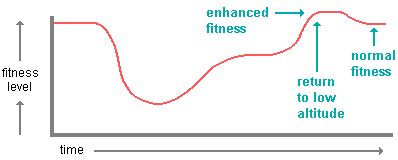There are two
major kinds of environmental stresses at high altitude for humans. First, there are
the alternating daily extremes of climate that often range from hot,
sunburning
days to freezing nights. In addition, winds are often strong and humidity
low, resulting in rapid dehydration. Second, the air pressure is lower.
This is usually the most significant limiting factor
in high mountain regions.
|
Air
pressure |
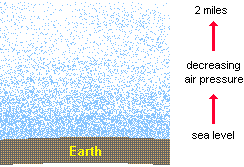 |
||
|
|
|||
|
Click here for more information about the earth's atmosphere |
|||
|
|
|||
The percentage of oxygen in the air at two miles (3.2 km.) is essentially the same as at sea level (21%). However, the air pressure is 30% lower at the higher altitude due to the fact that the atmosphere is less dense--that is, the air molecules are farther apart.
When we
breathe in air at sea level, the atmospheric pressure of about 14.7 pounds per square inch (1.04 kg. per cm.2)
causes oxygen to easily pass through selectively
permeable
![]() lung membranes into the blood. At high altitudes, the lower air
pressure makes it more difficult for oxygen to enter our vascular systems. The
result is hypoxia
lung membranes into the blood. At high altitudes, the lower air
pressure makes it more difficult for oxygen to enter our vascular systems. The
result is hypoxia
![]() , or oxygen
deprivation. Hypoxia usually begins with the inability to do normal physical
activities, such as climbing a short flight of stairs without fatigue. Other early
symptoms of "high altitude sickness" include a lack of appetite,
vomiting, headache, distorted vision, fatigue, and difficulty with memorizing and thinking clearly.
In serious cases, pneumonia-like symptoms (pulmonary edema
, or oxygen
deprivation. Hypoxia usually begins with the inability to do normal physical
activities, such as climbing a short flight of stairs without fatigue. Other early
symptoms of "high altitude sickness" include a lack of appetite,
vomiting, headache, distorted vision, fatigue, and difficulty with memorizing and thinking clearly.
In serious cases, pneumonia-like symptoms (pulmonary edema
![]() )
due to hemorrhaging in the lungs
and an abnormal accumulation of fluid around the brain (cerebral edema
)
due to hemorrhaging in the lungs
and an abnormal accumulation of fluid around the brain (cerebral edema
![]() )
develop. Pulmonary and cerebral edema usually
results in death within a few
days if there is not a return to normal air pressure levels.
There is also an increased risk of heart failure due to the added stress
placed on the lungs, heart, and arteries at high altitudes.
)
develop. Pulmonary and cerebral edema usually
results in death within a few
days if there is not a return to normal air pressure levels.
There is also an increased risk of heart failure due to the added stress
placed on the lungs, heart, and arteries at high altitudes.
When we travel to high mountain areas, our bodies initially develop inefficient physiological responses. There is an increase in breathing and heart rate to as much as double, even while resting. Pulse rate and blood pressure go up sharply as our hearts pump harder to get more oxygen to the cells. These are stressful changes, especially for people with weak hearts.
|
Initial inefficient |
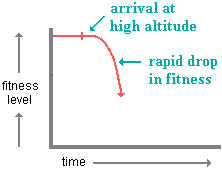 |
Later, a more efficient response normally develops as acclimatization takes place. Additional red blood
cells and capillaries
![]() are produced to carry more oxygen.
The lungs increase in size to facilitate the osmosis
are produced to carry more oxygen.
The lungs increase in size to facilitate the osmosis
![]() of oxygen and carbon dioxide. There
is also an increase in the vascular network of muscles which enhances the transfer of
gases.
of oxygen and carbon dioxide. There
is also an increase in the vascular network of muscles which enhances the transfer of
gases.
|
Beginning of |
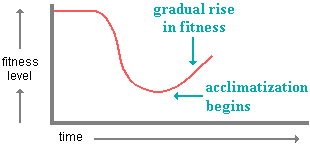 |
However, successful acclimatization rarely results in the same level of physical and mental fitness that was typical of altitudes close to sea level. Strenuous exercise and memorization tasks still remain more difficult. In addition, the rate of miscarriages is usually higher at altitudes above two miles because fetuses receive less oxygen from their mothers.
|
Increased fitness |
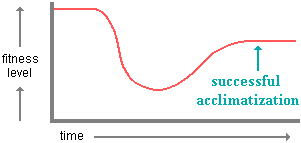 |
On returning to sea level after successful acclimatization to high altitude, the body usually has more red blood cells and greater lung expansion capability than needed. Since this provides athletes in endurance sports with a competitive advantage, the U.S. maintains an Olympic training center in the mountains of Colorado. Several other nations also train their athletes at high altitude for this reason. However, the physiological changes that result in increased fitness are short term at low altitude. In a matter of weeks, the body returns to a normal fitness level.
|
Enhanced fitness level for a short period of time after returning to low altitude |
|
Who Is Most
Likely to Have High Altitude Sickness?
Most lowland people begin to develop hypoxia symptoms at 1-2 miles altitude. However, there are some permanent settlements in the Andes Mountains in South America and the Himalaya Mountains in Asia that are at altitudes of 3 miles. Mountain climbers have reached peaks that are over 5 miles high, but only rarely without using tanks of oxygen to assist in breathing. The highest peaks are too high for any human to acclimatize to the point that they could stay there for prolonged periods.
|
Climbers at the
top |
 |
There is considerable variability between individuals and between populations in their ability to adjust to the environmental stresses of high mountain regions. Usually, the populations that are most successful are those whose ancestors have lived at high altitudes for thousands of years. This is the case with some of the indigenous peoples living in the Andes Mountains of Peru and Bolivia as well as the Tibetans and Nepalese in the Himalaya Mountains. The ancestors of many people in each of these populations have lived above 13,000 feet (ca. 4000 meters) for at least 2,700 years.
|
Peruvian Indian |
 |
|
|
(Her cheeks are
red primarily due to increased |
The implication is that natural selection
over thousands of years results in some populations being genetically more suited to the
stresses at high altitude. However, different
populations respond physiologically to low oxygen pressure in somewhat
different ways. The primary solution of Indians from the high mountain
valleys in Peru and Bolivia has been to produce more hemoglobin
![]() in
their blood and to increase their lung expansion
capability. Both result in an increase of oxygen
carried by the blood. In contrast, the common solution of Tibetans and Nepalese who live at
high altitudes generally has been to breathe
faster in order to take in more oxygen and to have
broader arteries and capillaries, thereby allowing much higher rates of
blood flow and subsequently greater amounts of oxygen delivered to their
muscles, despite the fact that they have relatively normal hemoglobin levels.
A recent study of Tibetan villagers who live their lives at around 15,000
feet has shown that they have 10 oxygen-processing genes not commonly found
in lowland populations. The EPAS1 gene is particularly important in
adapting to environments with consistently low oxygen pressure.
in
their blood and to increase their lung expansion
capability. Both result in an increase of oxygen
carried by the blood. In contrast, the common solution of Tibetans and Nepalese who live at
high altitudes generally has been to breathe
faster in order to take in more oxygen and to have
broader arteries and capillaries, thereby allowing much higher rates of
blood flow and subsequently greater amounts of oxygen delivered to their
muscles, despite the fact that they have relatively normal hemoglobin levels.
A recent study of Tibetan villagers who live their lives at around 15,000
feet has shown that they have 10 oxygen-processing genes not commonly found
in lowland populations. The EPAS1 gene is particularly important in
adapting to environments with consistently low oxygen pressure.
Whether you personally will experience high altitude sickness in the future may be at least partly a consequence of your genetic inheritance. Those individuals who have low expression levels of the PDP2 gene generally have more severe symptoms. This gene codes for a protein that assists in the conversion of food into fuel for our bodies. In some way, it apparently also helps in acclimatization to low oxygen pressure.
NEWS: In the March 15, 2011 issue of the
Journal of Epidemiology & Community Health, researchers from the
University of Colorado School of Medicine and the Harvard School of Global
Health reported that people generally live longer at high altitudes and have
a lower risk of dying from coronary artery disease. This positive
effect occurs unless people have chronic breathing problems. The
researchers speculated that mild hypoxia improves the way the heart
functions and produces new blood vessels that increase blood flow for the
heart. An alternative explanation presented by the authors is that
increased exposure to ultraviolet radiation from the sun at higher altitudes
increases the body's ability to produce vitamin D, which has beneficial
effects on the heart.
